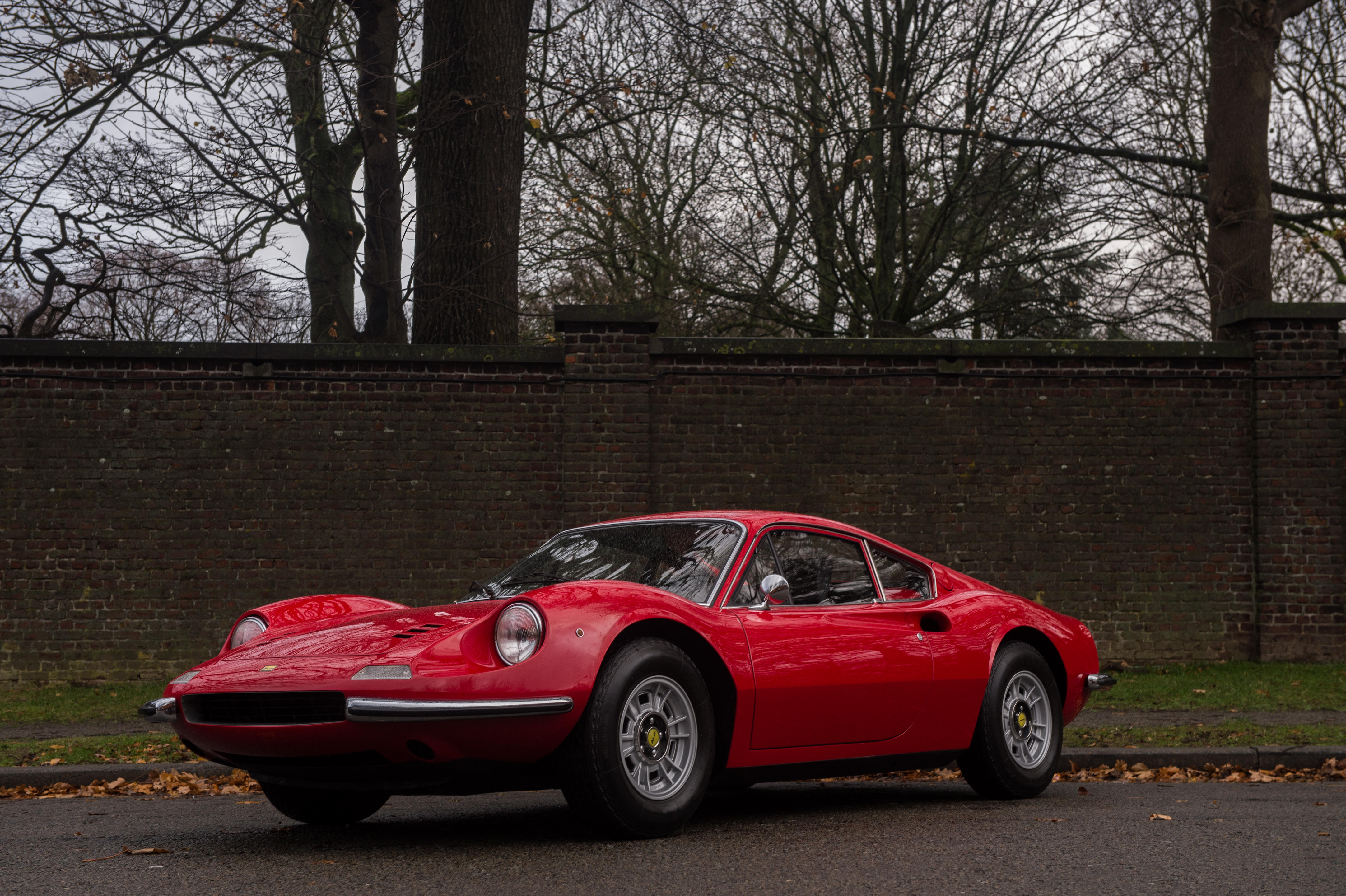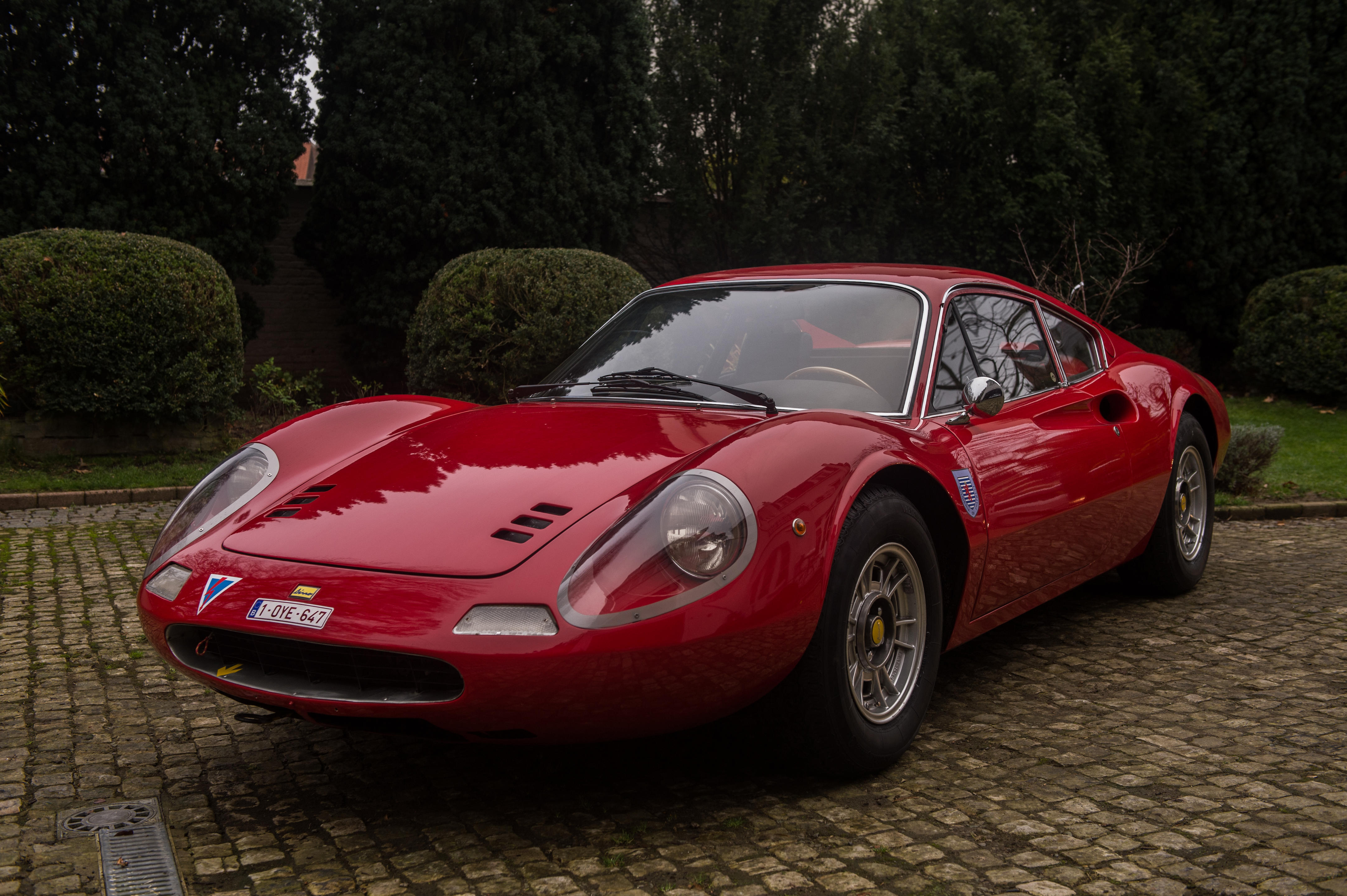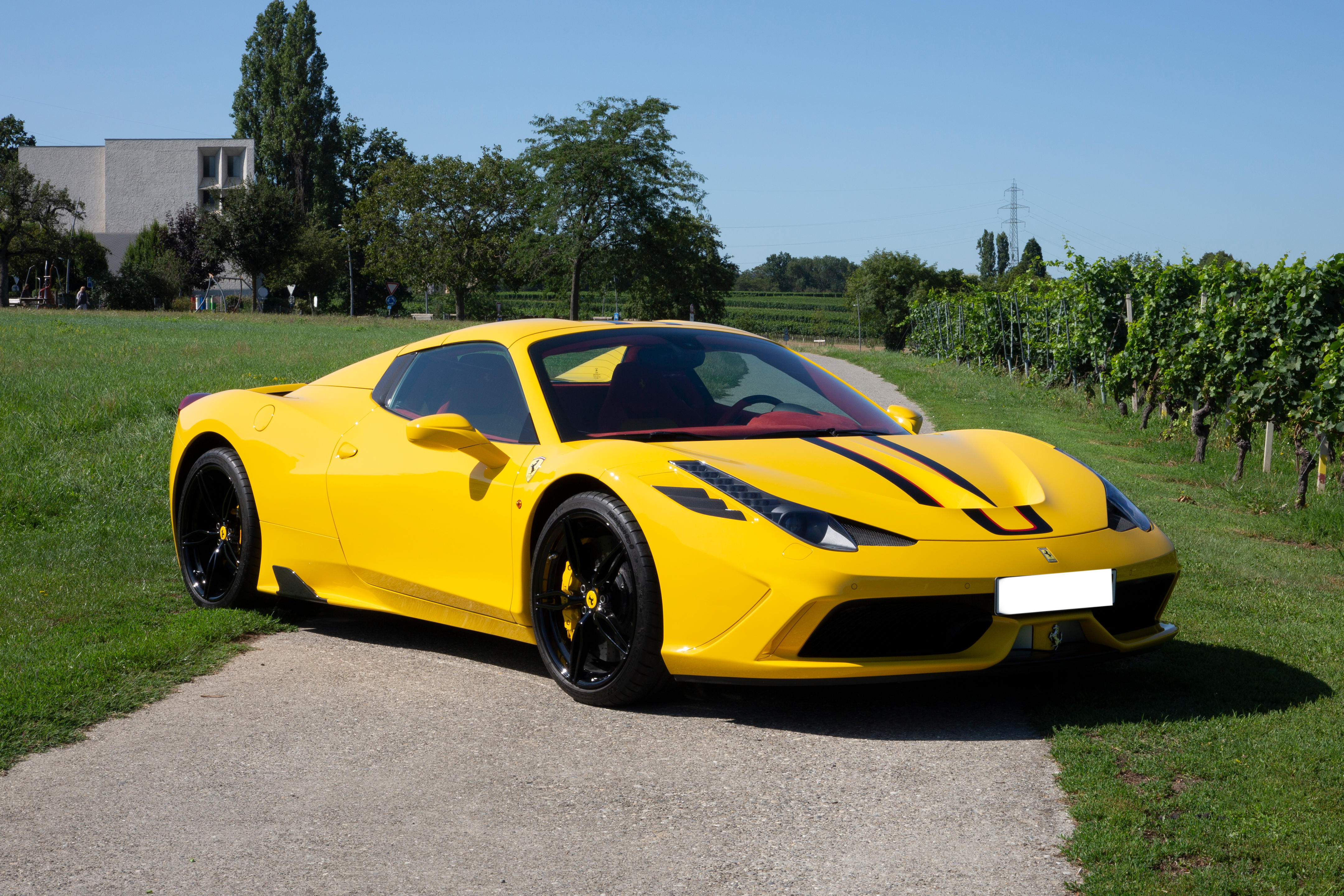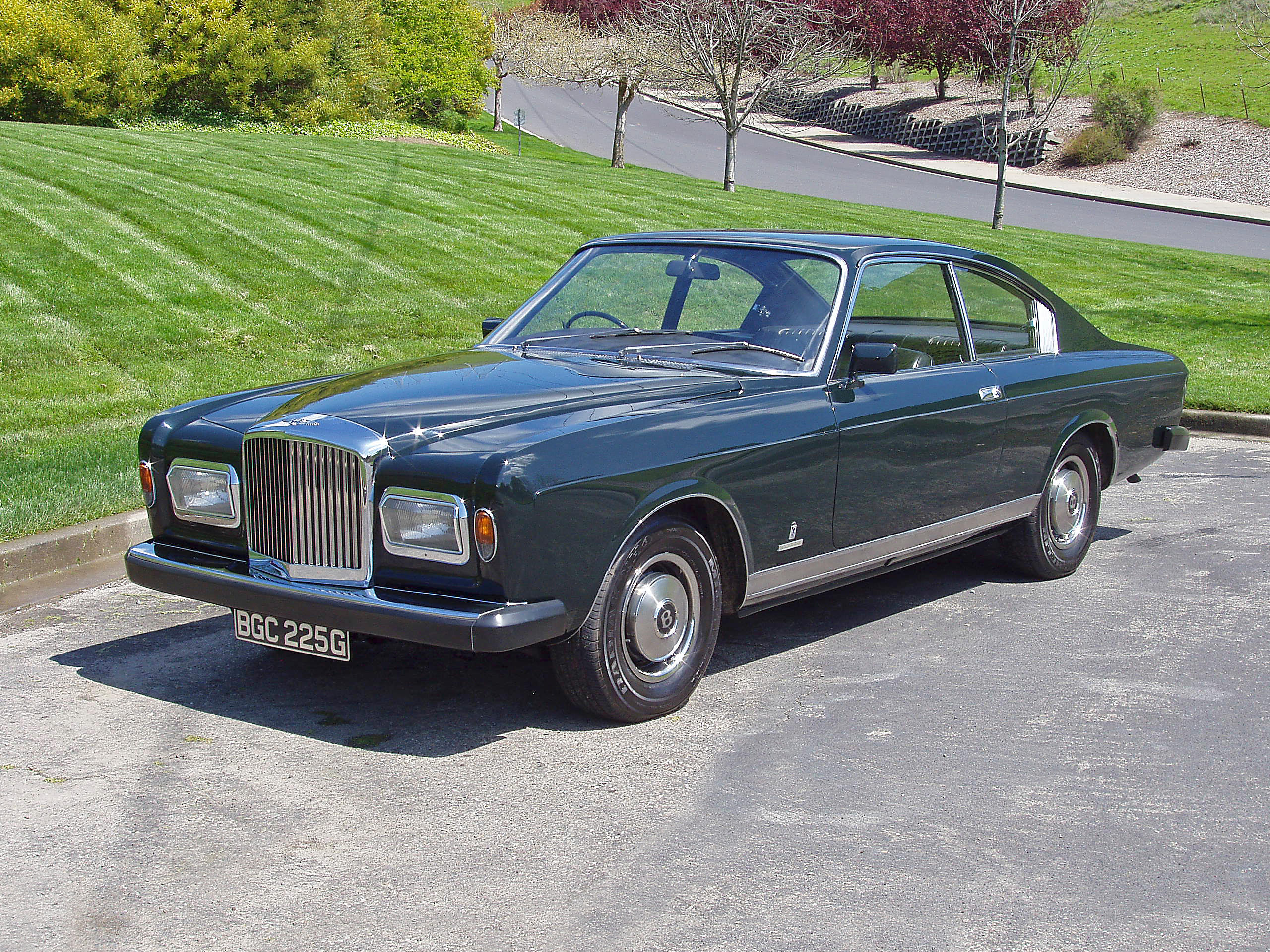This beautifully made Historic racing car is the last of four cars originated to the 1960 Ferrari Dino 246 design by celebrated marque specialists Bob Houghton and the late David Clark’s famous Graypaul Motors company here in England. This well-known project was intended initially to employ original mechanic components acquired from Ferrari which dated back to the heyday of the original works team cars during the final season of 2½-litre Formula 1 racing in 1960. The Ferrari Dino 246/60 was at that time the ultimate expression of the Italian front-engined Grand Prix car. Although Ferrari was also following the Cooper Car Company’s 1959 World Championship-winning lead into rear-engined configuration, their spearhead model for the new year’s World Championship was this kind of all-independently suspended 2.4-litre quad-cam V6-engined projectile. These cars were very much lightened developments of the de Dion-rear axled 1958-59 Dino 246s which had carried Mike Hawthorn to the Drivers’ World Championship that initial season, and Tony Brooks to within an ace of becoming the second Briton ever to win the World title in 1959. At the beginning of the 1958 season full 2.4-litre Formula 1 Dino 246 V6 cars won the Syracuse GP in Sicily (driven by Luigi Musso), the Glover Trophy at Easter Monday Goodwood (Mike Hawthorn) and the the BRDC International Trophy race at Silverstone (Peter Collins . Hawthorn went on to win the French Grand Prix outright at Reims-Gueux while Peter Collins won the British GP with Hawthorn 2nd. Mike Hawthorn eventually became the first-ever British World Champion Driver when he clinched the title by one point from Vanwall driver Stirling Moss in the deciding Moroccan GP at Casablanca. In 1959 modified Ferrari Dino 246/59 cars emerged equipped with voluptuous new Fantuzzi bodywork plus Dunlop disc brakes and tyres. Jean Behra and Tony Brooks finished 1-2 in the Aintree ‘200’ and Tony won the French and German GPs, only finally losing his strong chance of the World Championship title in the very last round of that year’s competition, at Sebring in Florida. For the 1960 season very much lightened Dino 246/60 cars were developed, which were built with the V6 engine angled across the frame the opposite way to 1959 – in this case from left-front towards right-rear - and with the transaxle gearboxes turned around to match, which confronted the drivers with a reversed gearchange gate…on the other side of the cockpit. The 246/60s also featured pannier fuel tanks without separate covering body panelling, smaller tail tanks and all-independent coilspring-and-wishbone suspension – Ferrari’s old faith in de Dion systems having finally been filed under ‘S’ for ‘Storica’ (history). But by that time both BRM and Lotus had followed Cooper into rear-engined configuration, and on most circuits the front-engined Ferrari Dinos were out-handled, out-braked and out-accelerated. This situation does not apply within today’s front-engined category of Historic Grand Prix car racing, in which the Dino 246 is very much a front-running proposition, opposed essentially by the front-engined 4-cylinder BRM Type 25. In the last Goodwood Revival Meeting, in September, veteran F1 driver Richard Attwood won outright in one of this Dino 246/60’s sister Graypaul-built cars. For the 1960 season-opening Argentine Grand Prix at Buenos Aires, Ferrari works drivers Count Wolfgang ‘Taffy’ von Trips and Cliff Allison both ran latest-model 4-cam cars, these engines moved back and now angled in the new direction from left-front towards right-rear passing the propshaft through steady bearings along the right side of the cockpit. Both these cars shrouded their new pannier tanks within bulged Fantuzzi body panelling. Allison inherited a 2nd place finish, while Trips placed 5th. At Spa in the 1960 Belgian Grand Prix, Phil Hill was at last able to use the 4-cam V6’s surviving horsepower advantage in a definitive Dino 246/60 model virtually identical to the beautiful
This beautifully made Historic racing car is the last of four cars originated to the 1960 Ferrari Dino 246 design by celebrated marque specialists Bob Houghton and the late David Clark’s famous Graypaul Motors company here in England. This well-known project was intended initially to employ original mechanic components acquired from Ferrari which dated back to the heyday of the original works team cars during the final season of 2½-litre Formula 1 racing in 1960. The Ferrari Dino 246/60 was at that time the ultimate expression of the Italian front-engined Grand Prix car. Although Ferrari was also following the Cooper Car Company’s 1959 World Championship-winning lead into rear-engined configuration, their spearhead model for the new year’s World Championship was this kind of all-independently suspended 2.4-litre quad-cam V6-engined projectile. These cars were very much lightened developments of the de Dion-rear axled 1958-59 Dino 246s which had carried Mike Hawthorn to the Drivers’ World Championship that initial season, and Tony Brooks to within an ace of becoming the second Briton ever to win the World title in 1959. At the beginning of the 1958 season full 2.4-litre Formula 1 Dino 246 V6 cars won the Syracuse GP in Sicily (driven by Luigi Musso), the Glover Trophy at Easter Monday Goodwood (Mike Hawthorn) and the the BRDC International Trophy race at Silverstone (Peter Collins . Hawthorn went on to win the French Grand Prix outright at Reims-Gueux while Peter Collins won the British GP with Hawthorn 2nd. Mike Hawthorn eventually became the first-ever British World Champion Driver when he clinched the title by one point from Vanwall driver Stirling Moss in the deciding Moroccan GP at Casablanca. In 1959 modified Ferrari Dino 246/59 cars emerged equipped with voluptuous new Fantuzzi bodywork plus Dunlop disc brakes and tyres. Jean Behra and Tony Brooks finished 1-2 in the Aintree ‘200’ and Tony won the French and German GPs, only finally losing his strong chance of the World Championship title in the very last round of that year’s competition, at Sebring in Florida. For the 1960 season very much lightened Dino 246/60 cars were developed, which were built with the V6 engine angled across the frame the opposite way to 1959 – in this case from left-front towards right-rear - and with the transaxle gearboxes turned around to match, which confronted the drivers with a reversed gearchange gate…on the other side of the cockpit. The 246/60s also featured pannier fuel tanks without separate covering body panelling, smaller tail tanks and all-independent coilspring-and-wishbone suspension – Ferrari’s old faith in de Dion systems having finally been filed under ‘S’ for ‘Storica’ (history). But by that time both BRM and Lotus had followed Cooper into rear-engined configuration, and on most circuits the front-engined Ferrari Dinos were out-handled, out-braked and out-accelerated. This situation does not apply within today’s front-engined category of Historic Grand Prix car racing, in which the Dino 246 is very much a front-running proposition, opposed essentially by the front-engined 4-cylinder BRM Type 25. In the last Goodwood Revival Meeting, in September, veteran F1 driver Richard Attwood won outright in one of this Dino 246/60’s sister Graypaul-built cars. For the 1960 season-opening Argentine Grand Prix at Buenos Aires, Ferrari works drivers Count Wolfgang ‘Taffy’ von Trips and Cliff Allison both ran latest-model 4-cam cars, these engines moved back and now angled in the new direction from left-front towards right-rear passing the propshaft through steady bearings along the right side of the cockpit. Both these cars shrouded their new pannier tanks within bulged Fantuzzi body panelling. Allison inherited a 2nd place finish, while Trips placed 5th. At Spa in the 1960 Belgian Grand Prix, Phil Hill was at last able to use the 4-cam V6’s surviving horsepower advantage in a definitive Dino 246/60 model virtually identical to the beautiful















Try LotSearch and its premium features for 7 days - without any costs!
Be notified automatically about new items in upcoming auctions.
Create an alert